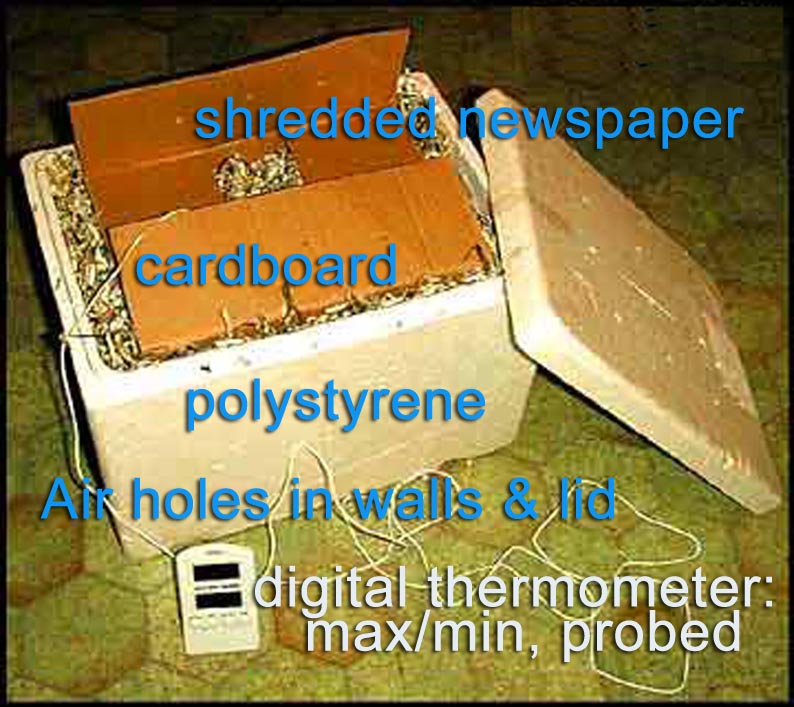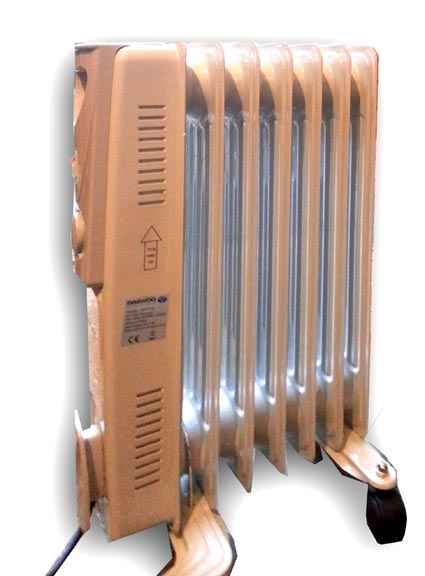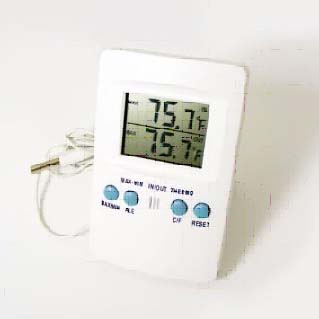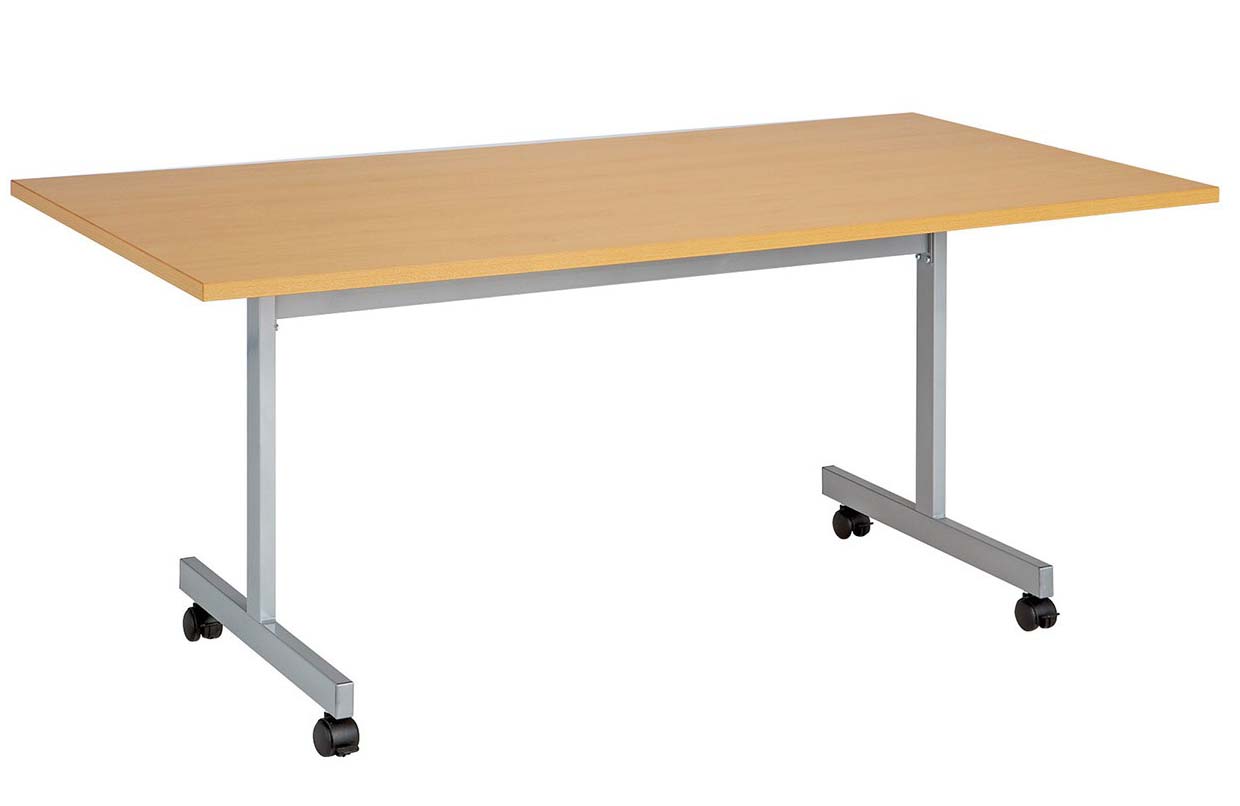Husbandry
through the year
Late Summer and Autumn, preparing for hibernation
Although they are quite able to hibernate in their first year (after all that is what happens in the wild), I find it is advantageous to their achieving a smooth shell shape if they spend their first few months with a humid substrate, and this can be extended to their first winter. I use well-soaked coco coir which they dig themselves into, usually choosing the area under a lamp which is warm and humid as opposed to cold and damp. The moisture counteracts the drying effect of the lamps on the keratin, helping to keep growth smooth and avoid pyramiding. The density and conductive properties of a humid substrate also facilitates temperature auto-regulation for the tortoise, which a loose, dry substrate could not do.
I then hibernate them normally the next winter.
It
is not advisable to allow very small tortoises to hibernate for more than about
11 weeks, say from mid December until early March, so it is necessary to
'stretch' the summer at both ends using your indoor
unit. This normally comes into use in September when the
nights start cooling off and you will need to bring in the babies at
night. Whilst the days are still warm, they can go outside during the day.
(Be very careful when there is danger of frost - always bring them
in). Gradually they will be spending more time in the indoor unit in which you
need to simulate summer using the equipment described. Try to place the
unit in a bright place and where the night time temperature is not less
than 12°C.
Between
October and December, gradually shorten the day length (full
spectrum light or combi lamp) a little at a time from 12 hours down to 8 (manually or using a
time switch) and gradually decrease the temperature (basking light or
combi lamp) by
altering the setting on the thermostat or moving the light further away. During
this period they will gradually wind down their eating and activity. They
are emptying their guts ready for hibernation. This is both natural and vital,
and sufficient ambient heat is needed for this to take place; if not, there is
danger that the tortoises will go into hibernation with a full gut, the
commonest cause of hibernation fatalities. They know instinctively what to do
and we should not encourage them to eat any more than they choose to at this
time, rather the opposite. They need a period of three to four weeks (dependant
on the tortoise's size) without food but with temperatures sufficiently high to
continue digestion. A few warm shallow baths during this time will
help them to 'empty down' and ensure they are sufficiently hydrated. Sometimes
the 'last poo' has a blob of mucus on the end. As the
night-time temperature should not fall below 10° or 12°C during this period,
some additional background heat may be needed if the unit is in a very cool
room or a greenhouse. Do allow the temperature to drop at night, as this helps to signal
to them that winter is coming.
Because
of this gradual winding down of day length and temperature they will spend a
little longer each day hiding as they sense the approach of winter until finally
they cease to emerge at all and are ready to hibernate.
Hibernation
At
this stage I put them in a cardboard box containing shredded newspaper
and put this into a thick-walled polystyrene box (of the type used for
transporting tropical fish) with several small ventilation holes
penetrating both boxes, and more shredded paper filling the space between the
outer and inner boxes. This goes first into a cool room and finally into
a frost-free, unheated utility room - garages and attics can get too
cold. An oil-filled radiator on a frost setting is an excellent addition. Check regularly that the
tortoises are not trying to climb out -
normally they will dig down to the bottom to hibernate, so you are likely
to hear creakings and digging sounds for the first few days. It is vital to
monitor the temperature with a max/min
thermometer. (The digital type with a probe is the most accurate, available from
mail order companies such as Maplin Electronics or on eBay). If the temperature falls below
1°C there is serious danger of the tortoise's tissues being frozen and
equally if it gets to much over 10°C for more than a couple of days, the tortoise could become active and try
to climb out, so you may need to move the box occasionally. Around 5°C
is ideal.
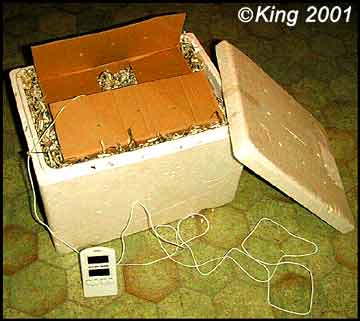
NB
Hibernation is an important part of your tortoise's natural cycle and should
only be avoided if it is underweight or sick.
There are two main methods of achieving a cool environment for hibernation, Fridge hibernation and Box hibernation. The fridge method is popular especially where people do not have an outbuilding, and it is reasonably easy to maintain a steady temperature of around 5C. The fridge needs to be a larder fridge, ie one without a freezer compartment, and it is important to get the correct temperature established before putting the tortoise in. For the tortoise to feel 'dug in' it is best if it can be placed in a container of shredded newspaper or topsoil rather than be 'naked' on the shelf. In both fridge and box hibernation, tortoises like to feel they have the option to dig down deeper when it is colder, as they do in the wild, so a deep rather than shallow box is preferable.
|
ESSENTIALS FOR NON-FRIDGE HIBERNATION ('BOX HIBERNATION')
|
|
|
By Linda King December, 2016 |
|
|
Essentials: |
|
1. Choosing a spaceThe space needs to be brick or block built, and not included in centrally heated parts of your home. It needs to be frost free and insulated. Part of a garage partitioned off and insulated is ideal. A loft is unsuitable because it is likely to get far too cold due to the heat from the house being excluded due to loft insulation. A cellar can be suitable but temperatures need to be tested well in advance. An unused bedroom is unlikely to be suitable as it will get too warm. Q. What would happen if the space got too warm? A. It is vitally important that the hibernation is cold enough. If the temperature rises to a level that wakes the tortoise and it becomes active, it will start using its precious fat stores accumulated over the summer and so is in danger of death. Q. What would happen if the temperature fell too low? A. If the temperature falls below freezing, the tortoise’s tissues are likely to be frozen causing death, and in the case of eyes, causing blindness even if the tortoise survives.
|
|
2. Temperature maintenanceThe temperature needs to be somewhere between 3C and 7C, with 5C being ideal. To maintain a safe temperature, the following are needed: A. Insulation of the building – if you are using a garage or other outbuilding, it can be insulated quite easily and cheaply and various sheet materials are available at builders’ merchants. It makes a vast difference to the rate of heat exchange, so it protects against extremes of cold and also from getting too warm when temperatures rise unseasonably. B. Insulation of the tortoise box:
|
|
|
|
|
|
i. A polystyrene box containing a cardboard box filled with shredded newspaper. Newspaper is much softer than copy paper which should not be used as it can cut the tortoise’s skin. The gap between the outer and inner boxes should also be filled with shredded newspaper. The tortoises should not have direct access to the polystyrene. ii. A wooden box filled with topsoil and/or shredded newspaper iii. A plastic box is harder to insulate but can be filled with topsoil more easily than cardboard. · In all cases a number of small air holes should be made in the walls and lid of the box, that run all the way from the outside to the inner box, and care must be taken not to block or seal over these. · The box should be deep enough for the tortoise to dig down in response to its instincts. · The box needs to be well secured so the tortoise cannot push the lid off and climb out. · It is important to shred the paper into short strands, ideally no longer than 3cm, as longer ones can get caught around legs and necks. · It is important too to avoid newspaper which has any chemical smell, as some (not all) printing inks contain VOCs (Volatile Organic Compounds). Although no problems have been reported associated with this, it is good to stay aware. It is possible to buy unprinted newspaper for home shredding, even available on eBay, so you can have the reassurance that there is no chance of contamination with VOCs. · Similarly, some cardboard box manufacturers use formaldehyde in the glue used for lamination, so always avoid any box which has a chemical smell. |
|
|
C. A background heater: I use an oil-filled radiator on a low setting. It only kicks in when the temperatures fall low enough so is extremely cheap to run. I actually have two in the space in case one should fail.
|
Oil-filled radiator |
|
Max-Min thermometer |
|
3. Temperature monitoringA digital, probed, max/min thermometer (more than one ideally). Some of these also have an alarm you can set to sound if the temperature rises ar falls beyond the ideal range.
|
|
4. Rodent protectionPossibilities include fine wire mesh around the box, wire mesh across any handle holes in wooden boxes, raising the box up on a table with non climbable legs – achieve this by the staddle stone principle, ie the tabletop is much wider than the legs area and protrudes beyond the footprint – rodents can’t walk upside down. A pedestal table is another good option. Traps on the floor (protected inside a plastic box with a hole in it, so a tortoise could not access the trap if it managed to get onto the floor).
|
|
|
|
|
5. Checking your tortoise· Check temperatures in the box by means of the thermometer probe – daily · Check for urination - weekly · Check for weight loss – weekly - this can be done in the box · In the Spring when outside temperatures start to rise above 11C, check several times a day for creaking sounds as a determined tortoise can climb out or dig out of the side of a box once it wakes.
|
|
Early
Spring
In
the spring this process is reversed: around the middle of March or when the
weather suggests it, get the indoor unit ready and bring the hibernation box
into a warm room. After a while (maybe a day) you will hear rustling and they
will come up to the top. Pop them in a really bright place (sunshine or full
spectrum light strip)
with a spotlight for basking heat. Give them a shallow lukewarm bath,
allowing them to drink, warm up and soak, offer some young dandelion leaves and
they should be up and running within a few hours. As before, use the thermostat
to control the temperature (18°C at the cold end up to 32°C under the light)
and the time switch to control day length.
As
the season warms up they can go outside on warm days (and in again at
night) until it is warm enough to leave them out all the time, perhaps by late
May, and another season is underway!
Summer
During
the summer months the youngsters will come into their own as they respond to
temperatures closer to their natural climate. They will develop their own
routine of basking, feeding, exploring and sleeping whilst you observe them,
provide good quality wild food and keep their areas tended and safe.
They
are tough little creatures and will do fine with the basic conditions described.
Do monitor them well but don't coddle them too much!
Daily
Care
The
babies will need some daytime checking; although they can look
after themselves perfectly well, they do sometimes get themselves the wrong way
up and can't always right themselves. This could be potentially dangerous if
under a lamp or in hot sun. (Plenty of stones and plants help to deal with this
in outdoor environments; twigs and pieces of towelling scattered on the soil or
coir can be helpful in indoor units) You will
need to train a friendly neighbour to cover for you if you go away. If you go
away a lot or are usually out during the day you will not be around during their
activity period and so will be unable to observe their feeding, behaviour and
health.
If this is the case you should think again about the
responsibility of taking on young tortoises,
animals
with the potential to outlive ourselves, and even our children, given the
right care.
All graphics and text in this site © L King 1998-2018
